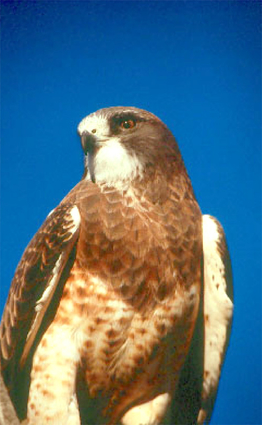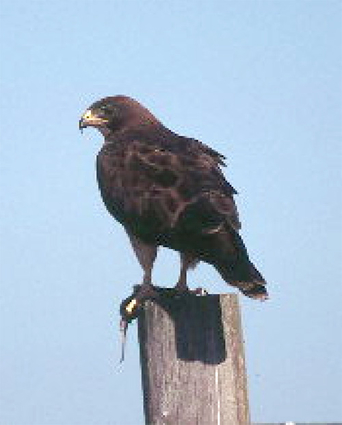Storied hawk's return to Site 300 a good omen
A hawk’s return can be significant news. The "Global Hawk," an unmanned aircraft from Edwards Air force Base flown 4,000-plus hours in support of combat operations in Iraq, has recently returned. Red Sox fans, observing a red-tailed hawk perched at Fenway Park on opening day, find the sighting prophetic for the season ahead. The term has the ability to suggest powerful insight or vision.
Site 300 witnessed the return of an ancient buteo, the Swainson’s Hawk ( Buteo swainsoni ) to the property this spring. A pair was discovered nesting in a blue oak in Paper Canyon in the southern quadrant of the site. Nesting pairs have been largely absent from this area of the Coast Range since the late-1800s, based on recorded surveys.
Swainson’s hawks are highly protected in the state (listed as "threatened") and are recognized as having one of the most extensive seasonal flight paths known to raptor species. Swainson’s hawks make an epic long distance migration as far south as Columbia and Argentina during the wintertime only to return to the United States in the spring.
In 1983, Swainson’s hawks were formally listed in the state of California by the Fish and Game Commission. At that time, biologists estimated that there were only 350 nesting pairs remaining statewide — a number indicative of a greater than 90 percent reduction in historic population levels. Today, the numbers are believed to have increased to roughly 1,800-2,000 pairs. This is relevant as the nesting pair distribution appears to be slowly growing, but ultimately may never reach levels (estimated at 20,000 nesting pairs) present at the time of pre-European settlement.
One of the major causes of the Swainson’s hawk population decline has been related to the application of pesticides on wintering grounds in Argentina. Hawks were ingesting pesticides (such as DDT) that farmers were applying to control grasshopper infestations. These wintering birds feed almost exclusively on insects.
Below are some little known facts about this bird-of-prey and its habits that local biologists are discovering after many hours in the field.
Central Valley Population
- In California, the majority of Swainson’s hawks occur in two distinct breeding populations: the Central Valley population (between Sacramento and Modesto, and the northern San Joaquin Valley) and the Great Basin population. Ninty-five percent of California’s Swainson’s hawks appear in the Central Valley region.
- Winter migration starts in August and September and birds amass in the southern area of the Central Valley prior to leaving. The entire North American migration (including birds from Canada and other west-and southwest states) has been estimated at about 500,000 during hawk counts conducted in Panama and Vera Cruz.
- Nesting Swainson’s hawks can be sensitive to changes in the environment around the nest site. To avoid nest abandonment, the California Fish and Game requires exclusion zones of .25 miles around active nest sites between March 1 and Sept. 15 for any new, intensive disturbances.
- A nesting female may lay up to four eggs. In scarce food years, more than half of the active nests do not produce fledged young; during abundant food years, nearly all eggs will result in fledged young. Rates of recruitment are primarily dependent on the local food supply and its availability.
- The female Swainson’s is generally larger than the male; biologists have noted that the female is generally the darker of the two in the Central Valley populations.
Identification tip: the Swainson’s hawk soars over grassland or plains with its wings held in a dihedral shape (slightly above horizontal). The long, pointed wings show a two-toned effect of pale wing linings (fore) and dark flight feathers (aft) on the underside.
One of the better places to observe this hawk is at the San Joaquin River National Wildlife. Bring a good pair of binoculars or a spotting scope.
What far-sighted news the Swainson’s Hawk brings to Site 300 is still to be discovered, but its return is a welcome reminder of the golden days of California’s youthful past and bodes well for the future.






